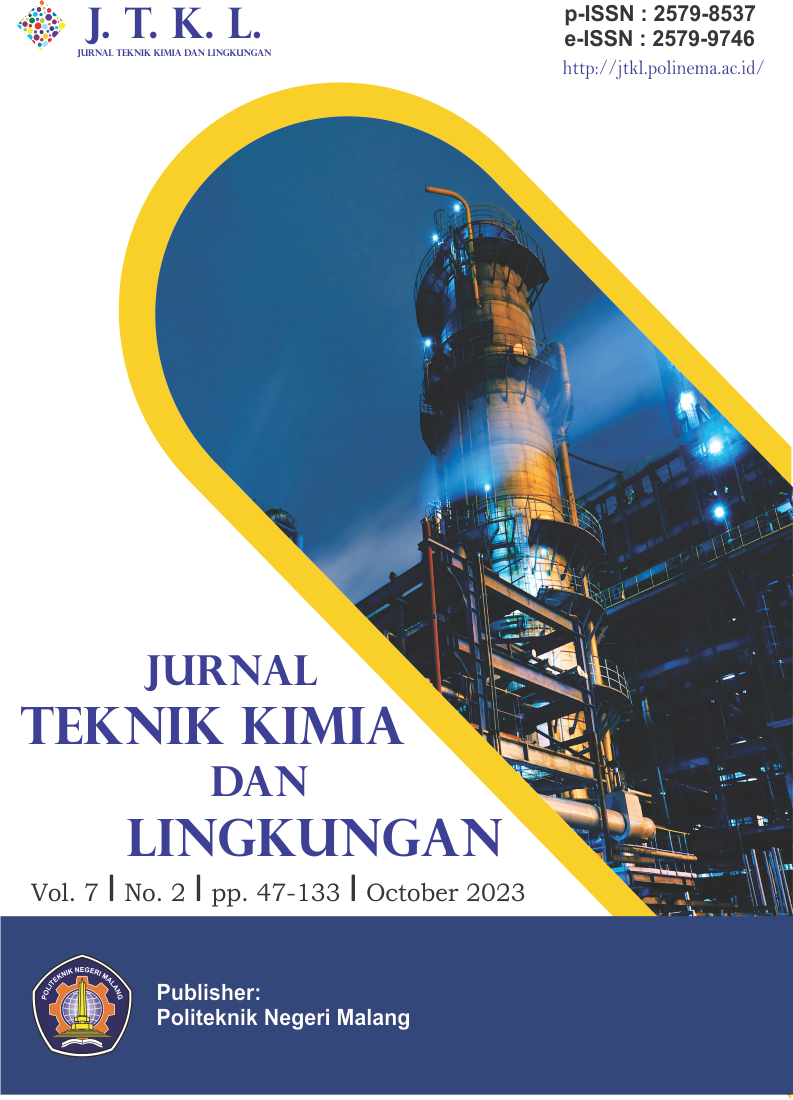Making Charcoal from Nipah (Nypa fruticans) Frond Waste as an Adsorbent to Extend the Shelf Life of Fresh Bread
DOI:
https://doi.org/10.33795/jtkl.v7i2.3643Keywords:
charcoal, fresh bread, nipah fronds, shelf lifeAbstract
Fresh bread has high potential for creating food waste that increases every year, because of its relatively short shelf life of 3-4 days after leaving the baking process. One way to extend the shelf life of bread is by using charcoal. Nipah fronds contain lignin elements that are good for charcoal. This study aims to determine the characteristics of charcoal from nipah fronds, the effectiveness of charcoal's ability to extend the shelf life of fresh bread, the effect of burning time, particle size and adsorbent mass on the storage time of fresh bread, the effect of the ratio of nipah frond adsorbent to commercial silica gel on the storage time compared to quality requirements of fresh bread of SNI 01-3840-1995 2013. Charcoal characterization includes quality tests based on SNI No. 06-3730-1995 on technical charcoal, namely water content and iodine absorption parameters and also Scanning Electron Microscopy (SEM) test. Based on the results of the study, charcoal from nipah frond waste has characteristics of water content that have met the quality standards of SNI 06-3730-1995 and in iodine absorbency only samples with pyrolysis time of 4 hours that have met the quality standards of SNI 06-3730-1995. Giving variations in charcoal burning time, mass and particle size of adsorbent powder affects the shelf life and quality requirements of fresh bread. Adsorbent packaging using teabags and silica gel paper can extend the shelf life of fresh bread up to 27 hours compared to those without adsorbent.
References
V. A. Dihni, Produksi Sampah Makanan Indonesia Tertinggi di Asia Tenggara, Databoks, 2022. https://databoks.katadata.co.id/datapublish/2022/06/27/produksi-sampah-makanan-indonesia-tertinggi-di-asia-tenggara (accessed Jan. 18, 2023).
S. Sachriani, Y. Yulianti, Analisis Kualitas Sensori dan Kandungan Gizi Roti Tawar Tepung Oatmeal Sebagai Pengembangan Produk Pangan Fungsional, Jurnal Sains Terapan, vol. 7, no. 2, pp. 26–35, 2021.
V. Puteri, L. Ramadhayanti, A. M. Miftah, N. Kurniaty, Perpanjangan Masa Simpan Roti dengan Penambahan Jahe Emprit (Zingiber Officinale Var Amarum), Pros. Farm., vol. 5, no. 2, pp. 674–679, 2019.
S. Sumartini, K. S. Harahap, N. Luthfiyana, Efektivitas Penambahan Serbuk Daun Mangrove (Sonneratia caseolaris) terhadap Kualitas dan Umur Simpan Roti Tawar, J. Pengolah. Has. Perikan. Indones., vol. 25, no. 2, pp. 281–293, 2022.
H. D. Rahmayanti, S. Ardiani, N. Akmalia, T. R. Kartika, M. Suryani, Karakterisasi Sifat Penyerapan Nata de Coco Kering Terpadatkan Terhadap Bolu, J. Fis., vol. 12, no. 1, pp. 37–41, 2022.
I. Apriyani, R. Farma, Pembuatan Elektroda Karbon Aktif Dari Tandan Kosong Buah Aren Dengan Variasi Suhu Karbonisasi, Komun. Fis. Indones., vol. 18, no. 58–63, p. 58, 2021.
S. Suryadi, H. Syafria, Pengaruh Level Inokulum Jamur Tiram Putih Terhadap Kandungan Fraksi Serat Pelepah Nipah, J. Peternak. Indones., vol. 24, no. 3, pp. 298–303, 2022.
A. W. Y. P. Parmita, A. D. Laksono, M. I. Zulkarnain, A. F. B. Hartanti, R. V. Mudhawammah, Karakteristik Buah Nipah Karbon Aktif dari Serabut Nipah Teraktivasi Potassium Hydroxide (KOH), Specta J. Technol., vol. 4, no. 3, pp. 72–79, 2020.
T. Evila, P. Sri, M. Nurhilal, R. Dwityaningsih, Analisis Proksimat dan Bilangan Yodium Sebagai Kajian Awal Aarang Tempurung Nipah Sebagai Bahan Intermediate Karbon Keras, J. Teknol. Ramah Lingkung., vol. 6, no. 3, pp. 248–260, 2022.
L. Legiso, H. Juniar, U. M. Sari, Perbandingan Efektivitas Karbon Aktif Sekam Padi dan Kulit Pisang Kepok sebagai Adsorben pada Pengolahan Air Sungai Enim, Prosiding Seminar Nasional Sains dan Teknologi, pp. 1–13, 2019.
A. Rahman, R. Aziz, A. Indrawati, M. Usman, Pemanfaatan beberapa jenis arang aktif sebagai bahan absorben logam berat cadmium (Cd) pada tanah sedimen drainase kota medan sebagai media tanam, J. Agroteknologi dan Ilmu Pertan., vol. 5, no. 1, pp. 42–54, 2020.
A. A. Yarangga, C. Danisworo, A. Harjanto, Studi Grafit Berdasarkan Analisis Petrografi dan Sem/Edx pada Daerah WindesiKabupaten Teluk Wondama, Provinsi Papua Barat, Prosiding Seminar Nasional XII Rekayasa Teknologi Industri dan Informasi, pp. 185–191, 2017.
T. Kusumaningtiyas, Pemanfaatan Asam Askorbat sebagai Penyerap Oksigen (Oxygen Absorber) untuk Memperpanjang Umur Simpan Roti Tawar, Bachelor Thesis, Institut Pertanian Bogor, Indonesia, 2018.
R. Idrus, B. P. Lapanporo, Y. S. Putra, Pengaruh Suhu Aktivasi Terhadap Kualitas Karbon Aktif Berbahan Dasar Tempurung Kelapa, Prism. Fis., vol. 1, no. 1, pp. 50–55, 2013.
W. Wardalia, Pengaruh massa adsorben limbah sekam padi terhadap penyerapan konsentrasi timbal, Jurnal Teknika, vol. 13, no. 1, pp. 71–80, 2017.
Downloads
Published
Issue
Section
License
Copyright (c) 2023 Ayu Nur Sabila, Theresia Evila Purwanti Sri Rahayu, Oto Prasadi

This work is licensed under a Creative Commons Attribution-NonCommercial 4.0 International License.







